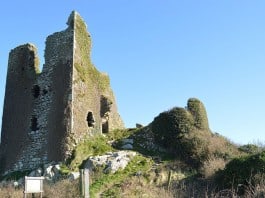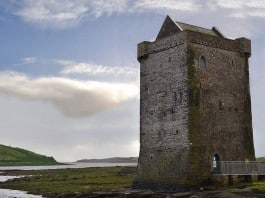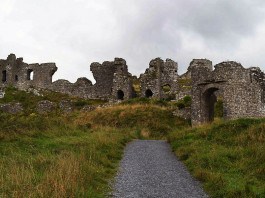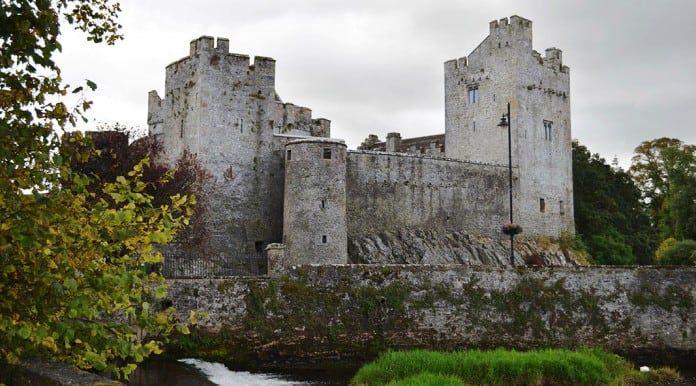
Cahir Castle, once the home of the famed Butler family, sits proudly on a rocky island in the River Suir in the middle of the town of Cahir, County Tipperary. Over the years it has gone through several revisions – particularly between the fifteenth and seventeenth centuries, when it was considerably enlarged and improved.
The raised rock on which Cahir Castle stands started life as an earthen fort or dún, which legend tells was the home of Finn MacRadamaid, a local Gaelic chief, and Badamair, his reputed lover. The first stone fort on the site was constructed by the King of Limerick (or Thomond as it was then) at some point in the 12th century to replace the earthen one. This type of fort was called a cathair – which accounts for the town’s name. As the end of the 12th century approached, most of Tipperary had been seized from the Irish and given to Theobald Walker, an ancestor of the influential Anglo-Norman clan that would later be so influential in the castle’s history, the Butler family. In 1375, many years before it fell to Cromwell from Lord Inchiquin, it came under the control of the third Earl of Ormond, James.
Many years later, in 1543, King Henry VIII settled the title of Lord Baron of Cahir on Thomas Butler to reward him for his great loyalty to the crown. Because his beloved only son died just after Thomas, leaving no other direct heir, the title passed to his nephew, Theobald. It would be Thomas, son of Theobald, who would join forces with the legendary Hugh O’ Brien and rebel against the English crown.
Because the castle took up most of the outcrop on which it stood, it was virtually impregnable in the days before more sophisticated weaponry – such as cannons – became the order of the day. However, by the year 1599, when the Earl of Essex, under orders from Queen Elizabeth I, arrived with his men to try to take the castle, they had the advantage of artillery, so it took just a few days to break down the castle’s defences, strong though they were.
The siege of Cahir was perhaps one of the most significant events in its long history. Essex arrived in Dublin in April 1599, accompanied by a remarkable sixteen thousand troops and over a thousand horses. He steered clear of Hugh O’Neill’s northern rebels, choosing instead to try to take the south of the country. The castle was a key location in the south, and any force hoping to move onwards towards the rebels in the west would need to take it before they could continue.
As we have seen, at this time the castle was owned by Thomas, the fourth Baron Cahir. However, he had left his brother James Galda (often referred to as ‘the Englishman) holding the reins while he was away with Essex. Essex had previously accused Thomas of being in cahoots with the rebels. Denying this, Thomas assured Essex that as soon as he saw the men come into view he would immediately surrender the castle.
On the 25th of May, as the sun started to rise, Essex ordered some of his men to start the arduous task of dragging the heavy cannons the ten miles that stood between their make-shift camp and the castle. They reassembled a mile away and re-grouped to prepare.
Thomas, Lord Cahir was ordered to go ahead to the castle to tell his brother to surrender and allow the English troops to enter the castle. However, James declined to do so, and Essex then ordered that both Thomas and his wife be placed under lock and key.
As evening fell, Essex looked for the castle’s weak spots and planned an attack that would exploit them. Cannons were set up on the east bank of the river, and on the morning of the 27th of May they opened fire. Though the cannons were firing from a point-blank position, they became damaged almost straight away, requiring repairs that took almost two days. Soon, though, the attackers fired fifty shots in quick succession, overcoming the defending garrison entirely. It is said that as the cannons fired, Thomas and his wife cried like little children.
During the night that followed, the garrison attempted to effect an escape; many were captured and slain, though some did manage to get away. That night the English found that they could enter the inner castle courtyards without being challenged.
Thus, on the morning of the 29th, Essex took the castle and garrisoned it with his men. He then continued across the river to confront the rebels in the west.
While Essex was full of self-importance about the sacking of Cahir, Queen Elizabeth took a rather different view, describing those that had sought to defend it as simply a ‘rabble of rogues’, thus demeaning Essex’s perceived achievement.
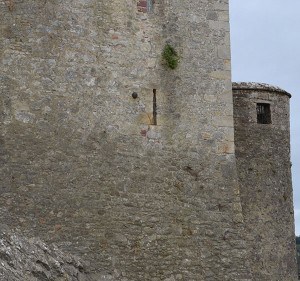
And indeed, soon after these events took place, Essex’s crusade came to an abrupt stop after he fled back to England to attempt to repair his relationship with the fractious and hard-to-please Queen. Shortly afterwards, in the year 1600, the castle was taken back by the rebels without a shot being fired. Short-lived the occupation of Essex’s men may have been, yet the damage they caused to the castle was extensive. Today you can still see the cannon ball that was embedded during the bombardment in the north-east tower wall.
In 1647 the castle was surrendered again – this time to Lord Inchiquin. Three years after that, he and his men abandoned it to Cromwell without putting up any fight at all. However, the family retained official possession of Cahir, having signed articles back in 1652. By the late 1700s, the immediate Butler family line came to an end and the castle fell into a state of steep decline, although it was restored, in part, during the 1840s by the Cahir branch of the family. In 1964, the Irish state acquired the Cahir Castle following the death of the final heir, and it gained the status of a National Monument. At this point in time, a faithful reproduction of the original portcullis was installed as part of an extensive programme of restoration.
Today the former Butler family seat of Cahir Castle is one of the most impressive and well-preserved castles in all Ireland. Many visitors will be familiar with it from seeing as a setting in films such as ‘Excalibur’ and ‘Tristan and Isolde’ and TV programmes such as ‘The Tudors’. The castle exudes an atmosphere that is entirely in keeping with its centuries of history, including its sackings by Essex and Cromwell and its surrender by Lord Inchiquin. It boasts an excellent and informative visitors’ centre, and there are plenty of places to park very close by (on a pay and display basis). While you are in the area, you could also visit the nearby Swiss Cottage, designed (it is thought) by John Nash and constructed around 1810 to be used as overflow accommodation for guests of Lord and Lady Cahir.

